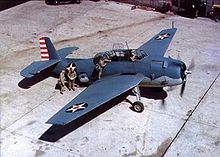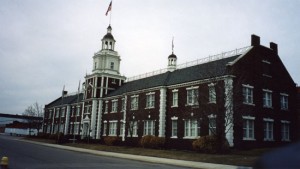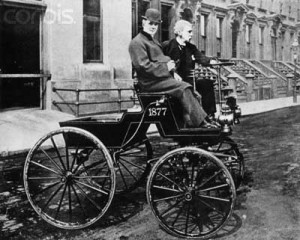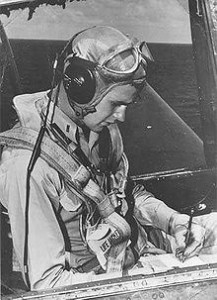The Hydraulic Press

“Return to Raven,” read the note at the top of the page. My Dad was addressing his brother Jim Socotra, 17 years his senior, and really more father than brother to my Dad. Jim went through the same portal that Raven is going through now, long ago, and the echoes of his passing illuminate Raven’s future.
Jim wrote in the margin “Very Interesting.”
The article is un-credited, but neatly typed, with hand-written corrections and marginalia. I had been going through the deceptively neat boxes of copied family correspondence, 1963-87. It is deceptive, in that the multiplicity of post-cards and stationary is now uniformly on 9×11 sheets of copy paper, but scrambled by year and month. It is numbing work, putting it all in chronologic order; maybe not as bad as screening old home video, life in excruciating real-time, but it was pretty close.
I don’t blame Pam, the proprietor of Step Above Copying in the Little Town by the Bay for having run screaming from the task. Just spending the afternoon with all that paper trying to organize it by year was awful.
This is only the thin edge of the wedge, I thought, a whole house full of files and documents and junk. No wonder people just back the garbage truck up to their parent’s places and hire people to shovel.
Still, I was committed to copying the mass of material, burning it to disc, and sending copies back to the folks still living who had originated the hundreds of pages of documents. I have the papers in stacks now, by years from 1963 to1987, and within each year by chronological date.
I am afraid that is about as good as it is going to get. Today, I intend to fed them all into the scanner and produce data discs so that everyone in the family gets a copy to ignore misfile or pass along to brain-numbed children.
The challenge is to ignore the contents so you don’t get bogged down. One document caught my eye, though, and I had to stop in the midst of the long line of years that stretched around my office. I had just finished a marvelous and depressing book by native Detroiter Paul Clemens about the closing and salvage operation that emptied out the old Budd Company on Charlevoix St.

The book is called “Punching Out: One Year in a Closing Auto Plant,” and describes the dismantling of the stamping lines that sent the automobile parts production to new plants in Mexico, India and Brazil.
None of it stayed in Detroit, or America, for that matter. That is what made the following document so poignant, since there was a time when we really needed presses.
I remembered hearing Jim tell the story in person. He was a famous story-teller, something that I guess is a compulsion that runs in the blood. I glanced at the title, remembering.
“The Hydraulic Press. Back in the 1930’s,” the story began, and it goes from there. It is one of several dozen quite remarkable vignettes in the mass, and I thought I would share it with you. It is a story about a country that doesn’t exist any more, one that built things, and didn’t offer a “full portfolio of Financial Services.”
Come on along on a visit to a different world. It will be more fun than doing the taxes or running things through the scanner.
“Back during the ‘30s the Samson United Corp., at Rochester, made a line of heat pads, electric fans, toasters and flatirons in a big red brick building dating to the turn of the century. When World War II came along, this firm landed a big contract to build .30 caliber gun turrets for the Grumman “Avenger” torpedo plane. Not all of their factory equipment was suitable for gun-turret production, and in turn, they were in desperate need of certain tools for the turrets that they had never had for the waffle iron business.
But, with American plunged into a huge war program, many other plants also desperately need tools, too. And it took time to produce all of these suddenly-need tools, and the war plants had to make-do the best they could until they became available.
The gun turret had an aluminum ginner’s seat, a compound, contoured share reminiscent of modern fiberglass molded chair styles.
To produce this shaped seat, Samson needed a hydraulic press to form and shape the aluminum. The exigencies of war production made it impossible to stop and redesign the seat for simpler manufacture on simpler tools. Too many turrets were already in service and all seats had to be interchangeable for repair purposes. No changes, however well-advised, were permitted by the Navy Department.
Samson had to make these seats by hand, the hard way, until they could get a hydraulic press, many months away. The Company brought in a silversmith from Gorham, a real artisan, who could fashion metal into beautiful contours by beating it with a hand hammer, a painfully slow process for wartime production. They found skilled coppersmiths, too, and this little group of craftsmen tap-tapped away ‘round the clock, seven days a week, beating out the gunner’s seats but were never quite able to meet the growing production demands.”
(Ed note: The Avenger entered service in 1942, and first saw action at the Battle of Midway, where Torpedo 8 took heavy losses, but drew the IJN defending fighters away from the dive-bombers that devastated the fast carrier force. Despite losing five of the six Avengers on its debut, it survived in service to become one of the outstanding torpedo bombers of the Pacific War. Greatly modified over its service life, the Avenger remained in use until the 1960s as a fire-fighting tanker.)
“One day a grubby old broom-pushing janitor who had been a fixture around the plant for longer than anyone could remember finally made himself heard above the wails of the production managers who hovered and wept over the little band of “tin knockers,” eager to snatch each gunner’s seat the moment it could be bulldozed through Inspection.
“Why,” the old man asked, don’t you use the hydraulic press you’ve got?”
It took a little while before anyone would pay any attention to the old man but his acid comments finally culminated in a safari down into a musty and long-abandoned basement. We climbed over a filthy little of old packing cases and the junk and debris of decades of neglected housekeeping. The place was musty and damp and full of cobwebs. No lights worked, and we could hear the scuttling of rats through the debris beneath our feet as we warily followed the old janitor, squirreling ahead of us through the dank cavern.
Eventually he turned a corner, and stopped, standing in a shallow pool of dirty drain water. In the rays of our flashlights there sat- sure enough- a big hydraulic press with a platen in the middle maybe four feet in diameter. It was encrusted with rust, shoddy with neglect, and looked like something that could have come over in the Ark.
But it was, undeniably, a press.
We could not afford to be finicky. We shoveled some of the junk out of the way, got the lights working and attacked the old thing with wire wheels, steel wool, chipping hammers, and grinders. We manage to break the big piston loose of its rust and draw it out of the deep cylinder beneath eh floor. It was pretty badly rusted. Instead of a smooth piston, it had deeply rusted rings where the packing gland- made of tarred rope!- had allowed it to corrode deep grooved rings. But we shined it up and smoothed it as best we could and put it back in place with a fresh rope-gland packing.
Meanwhile, another crew tackled the pimp. The press was operated by water, not oil. Beside the press was a three-cylinder pump with three different sizes of cylinders in a row; the big low-pressure cylinder, the medium pressure vessel and the smaller high-pressure cylinder.*
These tubes were set upright like three open buckets. We had to drive the rusted pistons out of the rusted cylinders with stout hammer-blows.
The three connecting rods reached all the way to an open crankshaft mounted on the ceiling! It looked like a small edition of an old steam engine on some ancient ferryboat. But, the day came when we turned on the new motor and waited to see if the great ram would rise up out of the floor. It did, slowly. And when the first corroded ring in the piston cleared the packing gland, there was a “spat” of water and a great gush of high pressure water shot out around the piston and soaked everybody in the place and hissed off the walls.
We were a dripping mess, shocked by the unexpected immersion in cold water. But the piston crept inexorably upward, sealing itself until the next corroded groove came up through the packing gland and soaked us all again- at least those who had not taken cover.
It worked.
We had dies ready to set on the platform, and indeed, the ancient press did crunch aluminum sheets into shape, and we were in business.
What a business! We built a steel shield for the operator to hide behind against the leaks of high-pressure water. He would load the old press, turn on the water valve, switch on the motor and retire behind his barricade. He had a stack of comic books to amuse himself.
As the pump chortled and squished, and the ram groaned and spat sheets of water out, he could get through the contents of about one Captain America book before he heard the sound of crinkling metal as the form dies squeezed home. When the pump started slowing in protest and the motor groaned and smoked, he would reach out from behind his shield and flip the water valve- and pick up another comic book. For the old press opened just as slowly as it closed; there was no “high-speed” return stroke.
Seven days a week, 24 hours a day, the old press formed gunner’s seats for the torpedo planes. Visiting Naval Officers came, watched, and went away shaking their heads. The old press never ailed for seven months of use. Eventually a modern high-sped oil-hydraulic press finally arrived to take over.
And where did the old press come from? What was it doing there?
We dug and scraped the rust off the cast-maker’s emblem and traced it probably date of manufacture to about 1905, by a company long defunct. And what was it for?

It had been used, originally, to press the solid rubber tires on the wooden wagon wheels of the original Selden automobiles, made in that old plant, natch!
And with this we fought the Japs**, in World War Two.”

* Ed note: I saw a similar arrangement on the remaining starboard powerplant of the ex-USS Olympia. The steam-plant was of the same vintage as this hydraulic press.
** Sorry, that is the way the narrator wrote it. Complain too loudly to the Greatest Generation and they might kick your ass.
Copyright 2011 Vic Socotra
www.vicsocotra.com
